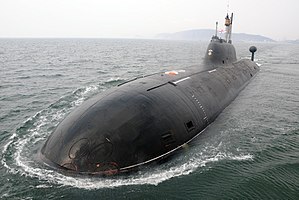Russian submarine K-152 Nerpa

INS Chakra
|
|
| History | |
|---|---|
|
|
|
| Name: | K-152 Nerpa |
| Namesake: | Baikal seal |
| Builder: | Amur Shipbuilding Plant, Komsomolsk-on-Amur |
| Laid down: | 1993 |
| Launched: | October 2008 |
| Commissioned: | 2009 |
| Fate: | Transferred on lease to the Indian Navy, 4 April 2012 |
|
|
|
| Name: | Chakra |
| Commissioned: | 4 April 2012 |
| Homeport: | Visakhapatnam |
| Status: | in active service |
| Badge: |  |
| General characteristics | |
| Type: | Nuclear-powered attack submarine |
| Displacement: | 8,140 tonnes (8,010 long tons) surfaced |
| Length: | 108.0–111.7 m (354.3–366.5 ft) (sources vary) |
| Beam: | 13.5 m (44 ft 3 in) |
| Draught: | 9.6 m (31 ft 6 in) |
| Date | 8 November 2008 |
|---|---|
| Location | Pacific Ocean, Sea of Japan, off the coast of Vladivostok |
| 20 killed | |
| 21 injured | |
| Accident occurred on board the Russian submarine K-152 Nerpa | |
INS Chakra is a 8,140-tonne (8,010-long-ton) Project 971 (or Project 518; NATO: Akula-class submarine) nuclear-powered attack submarine. Construction was started in 1993, but suspended due to lack of funding. The Indian Navy sponsored the building and sea trials of the submarine provided it was given to the Indian Navy on lease for 10 years. It was launched as K-152 Nerpa in October 2008 and entered service with the Russian Navy in late 2009. The submarine was leased to the Indian Navy in 2011 after extensive trials, and was formally commissioned into service as INS Chakra II at a ceremony in Visakhapatnam on 4 April 2012. The INS Chakra joined the Eastern Naval Command at Visakhapatnam.
While K-152 Nerpa was undergoing sea trials in the Sea of Japan on 8 November 2008, a fire suppression system was accidentally initiated. The accident killed 20 civilian specialists and navy crew members and injured 21 others.
Nerpa was laid down at the Komsomolsk-on-Amur shipyard in 1993, but its completion was delayed for nearly a decade due to a lack of funds caused by the economic crisis of the early 1990s. The partly constructed vessel was mothballed until 2004, when Rosprom (the Federal Agency for Industry) signed an agreement with the Indian government to complete the submarine and lease it to the Indian Navy. The vessel was intended to be completed by 2007, but underwent further delays. In 2007, it was transferred to the Vostok shipyard in the closed city of Bolshoy Kamen, Primorsky Krai, for fitting-out. It was launched in October 2008 for sea trials, following which it was due to be handed over to the Russian Defence Ministry. Reports in the Indian media suggest that the resumption of construction was underwritten with Indian funding.
The standards of the vessel's construction were criticised by several commentators. Alexander Golts, defence editor of the Yezhednevny Zhurnal newspaper, said that in the 1980s, the Amur shipyard turned out submarines "one after another, like pancakes," but from 1993 to 2008 had produced just one. "The old specialists had left, and the new ones lacked professionalism." An unnamed worker at the Amur shipyard told Komsomolskaya Pravda that there were "questions about the quality of the metal that was used in building the nuclear submarine", some of which had been bought from China, and alleged that "when the first trials of the submarine were carried out water was leaking in between the seams! So it is not surprising that the work dragged on."
...
Wikipedia
